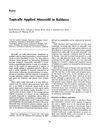TLDR Direct vasodilators and sympatholytic agents are still useful for certain conditions despite being less common due to side effects and newer drugs.
The document reviewed the use of direct vasodilators and sympatholytic agents, such as hydralazine and clonidine, in managing cardiovascular diseases, particularly hypertension and heart failure. Despite reduced use due to side effects and newer drug classes, these agents showed comparable blood pressure-lowering effects. Hydralazine had niche applications, including refractory hypertension, renal dysfunction, and pregnancy-induced hypertension, and was beneficial in combination with isosorbide dinitrate for systolic heart failure in African American patients. Minoxidil was effective for severe hypertension and renal dysfunction but had side effects like tachycardia and hypertrichosis. Alpha-1 adrenergic blockers (prazosin, terazosin, doxazosin) and alpha-2 adrenergic agonists (clonidine, methyldopa) were also discussed for their efficacy and side effects. The document emphasized the importance of these drugs in combination therapies, especially for patients with renal impairment, despite limited robust clinical trial data.
 74 citations
,
May 2004 in “Journal of Clinical Hypertension”
74 citations
,
May 2004 in “Journal of Clinical Hypertension” Minoxidil effectively treats severe hypertension, but watch for side effects.
 47 citations
,
October 1989 in “Circulation Research”
47 citations
,
October 1989 in “Circulation Research” The study explains how minoxidil sulfate causes vasodilation in rabbits by opening potassium channels and inhibiting calcium channels.
 26 citations
,
June 1983 in “Journal of Hypertension”
26 citations
,
June 1983 in “Journal of Hypertension” Minoxidil lowers blood pressure more effectively but has more side effects, so try hydralazine first.
 96 citations
,
October 1981 in “Drugs”
96 citations
,
October 1981 in “Drugs” Minoxidil effectively treats severe hypertension but may cause side effects, so careful monitoring is needed.
 11 citations
,
January 1980 in “Southern Medical Journal”
11 citations
,
January 1980 in “Southern Medical Journal” Minoxidil effectively treats severe hypertension but has notable side effects.
 26 citations
,
October 1978 in “JAMA”
26 citations
,
October 1978 in “JAMA” Minoxidil helps treat severe high blood pressure.
 21 citations
,
October 1978 in “The Journal of Clinical Pharmacology”
21 citations
,
October 1978 in “The Journal of Clinical Pharmacology”  86 citations
,
September 1977 in “BMJ”
86 citations
,
September 1977 in “BMJ” Minoxidil effectively controls blood pressure in severe cases, but has serious side effects and causes hair growth in women.
 102 citations
,
September 1977 in “The Lancet”
102 citations
,
September 1977 in “The Lancet” Minoxidil with propranolol and diuretics lowers blood pressure but causes fluid retention and hair growth.
 34 citations
,
January 1977 in “American Journal of Cardiology”
34 citations
,
January 1977 in “American Journal of Cardiology”  50 citations
,
September 1975 in “American Heart Journal”
50 citations
,
September 1975 in “American Heart Journal” Minoxidil effectively controls blood pressure in severe cases, but may cause fluid retention and edema.
 18 citations
,
January 1997 in “British Journal of Dermatology”
18 citations
,
January 1997 in “British Journal of Dermatology” 5% topical minoxidil can cause severe body hair growth, which disappears after stopping treatment.
 45 citations
,
November 1979 in “British Journal of Dermatology”
45 citations
,
November 1979 in “British Journal of Dermatology” Minoxidil causes excessive hair growth in almost all patients.
 1 citations
,
May 2007 in “International Journal of Dermatology”
1 citations
,
May 2007 in “International Journal of Dermatology” Minoxidil, when applied to the scalp, can stimulate hair growth but effects vary, stop if treatment ends, and it may cause side effects like fluid retention.
 August 2019 in “Reactions Weekly”
August 2019 in “Reactions Weekly” Oral minoxidil for hair loss caused mild side effects in some men, but most continued treatment.
September 2021 in “Zenodo (CERN European Organization for Nuclear Research)” Chemotherapy side effects might help treat autoimmune hair loss.
 26 citations
,
March 1985 in “International Journal of Dermatology”
26 citations
,
March 1985 in “International Journal of Dermatology” Minoxidil helps hair growth, but results vary.















